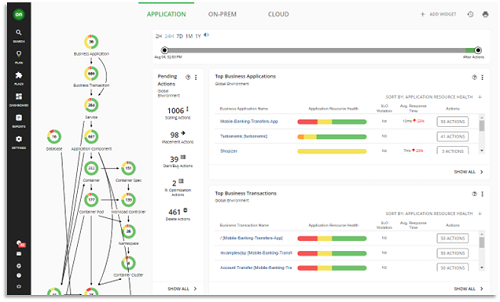
To ensure application performance and reduce risk to the business, organizations are turning to AI-powered automation to dynamically allocate resources and reduce IT costs.
While digitization of business had been underway for years, COVID accelerated the need for all businesses to compete online. In fact, McKinsey & Company noted that in 2019, 10 years of digitization was compressed into a single year. Organizations that made the transition to digital have come to realize that applications are now their business, and that their business is applications.
With new digital businesses come new pressures: complexity, the need for applications and IT services to be 100% available and ultra-performant, and to run without waste. Let’s examine these challenges individually:
Complexity: 80% of respondents in one survey report that they have at least 1,000 applications. One thousand! More applications require more time to monitor and optimize, but as we know, labor shortages abound and those that work in IT are strapped for time and may just over-provision resources to make sure they run.
Application Performance: Have you ever experienced a website where pages don’t load completely or transactions take too long to complete? In that case, you most likely abandon the site and just find another place to make a purchase or transact their business. Surveys have shown that a one-second latency in applications can reduce customer conversions by 7% and customer satisfaction by 16%. Flawless application performance is a must for your business.
Wasted Money and Resources: A common approach to ensure performance is to instrument everything in the application stack with Application Performance Management (APM) technology, but these specialized tools only focus on one part of the application stack (storage administrators have one tool, VM teams have another, and container administrators yet another) and are the catalyst for even more IT silos. Another common approach to reducing risk to the business is to over-allocate infrastructure resources. Organizations give their environment more resources than they need in the hopes that there is enough storage or that a database doesn’t become overwhelmed by lack of memory.
Traditional approaches for ensuring application performance fall short because they do not provide a holistic overview of the application ecosystem, and most importantly, they only tell you what is not working well. They don’t present you with what to fix and the impacts of the recommended optimizations.
That’s where Application Resource Management (ARM) solutions, such as IBM Turbonomic, add value. Turbonomic ensures that an application and the infrastructure it depends on have enough resources for optimal performance. Turbonomic does much more than alert you to poor performing applications and infrastructure- it identifies issues and tells you exactly how to eliminate them. The platform is so intelligent, it can take remediating actions automatically or present you with the optimizations and only act if approved by a human.
Turbonomic will dynamically allocate resources based on demand at a point in time, preserve your application SLAs, and reduce costs coming from guesswork infrastructure optimizations that result in starving your application or overprovisioning it. And if you’ve already invested in APM observability tools, Turbonomic can use data from them as an additional source for its optimization recommendations.
 This is the Turbonomic dashboard with application resource supply chain and where congestion occurs
This is the Turbonomic dashboard with application resource supply chain and where congestion occurs
ARM platforms like Turbonomic provide continuous, automated resource allocation for applications and reduce risk to your business.
If you are interested in learning more about how LRS can help you assure application performance and automate IT operations, while reducing cloud costs, please contact us to request a meeting.
About the author
Steve Cavolick is a Senior Solution Architect with LRS IT Solutions. With over 20 years of experience in enterprise business analytics and information management, Steve is 100% focused on helping customers find value in their data to drive better business outcomes. Using technologies from best-of-breed vendors, he has created solutions for the retail, telco, manufacturing, distribution, financial services, gaming, and insurance industries.